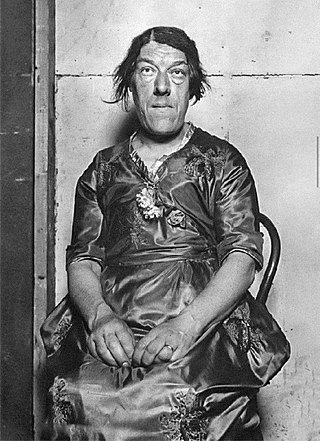In North America, a sideshow is an extra, secondary production associated with a circus, carnival, fair, or other such attraction.

Freaks is a 1932 American pre-Code drama horror film produced and directed by Tod Browning, starring Wallace Ford, Leila Hyams, Olga Baclanova, and Roscoe Ates.

William Henry Johnson, known as Zip the Pinhead, was an American freak show performer known for his tapered head.
Jane Barnell was an American bearded lady who worked in circus sideshows, dime museums and carnivals, who used various stage names including Princess Olga, Madame Olga and Lady Olga. In her only film role in Tod Browning's cult classic Freaks, using the sideshow stage name Olga Roderick, she was billed as the "Bearded Lady".

The Doll Family was an American quartet of sibling entertainers with dwarfism from Stolpen, Germany. They were popular performers in circuses and sideshows in the United States from the mid-1910s until their retirement in 1958. The family members—Gracie, Harry, Daisy and Tiny—also appeared briefly in films; they were best known as members of The Munchkins in the 1939 MGM film The Wizard of Oz.

Prince Randian, also nicknamed Pillow Man, The Snake Man, The Human Torso, The Human Caterpillar and a variety of other names, was a Guyanese-born American performer with tetra-amelia syndrome and a famous limbless sideshow performer of the early 1900s, best known for his ability to roll cigarettes with his lips.

Frances O'Connor was an American entertainer. Born without arms, she made her living appearing in circus sideshows billed as the armless wonder or the living Venus de Milo. She also did knitting and sewing with her feet as a hobby. She worked firstly with AI G Circus and then from the mid-1920s to the mid-1940s with Ringling Brothers and Barnum and Bailey travelling circuses.

An armless wonder was a person without arms who was exhibited, usually at a circus sideshow. Typically a woman, she would perform various tricks using her feet and toes, such as smoking a cigarette or writing. Frequently, she would have a supply of visiting cards which, for an extra charge, she would sign with her feet and give to onlookers.

Minnie Woolsey, billed as Koo-Koo the Bird Girl, was an American side show entertainer, best known for her only film appearance in Tod Browning's film Freaks in 1932.

Schlitzie, possibly born Simon Metz and legally Schlitze Surtees, was an American sideshow performer. He also appeared in a few films, and is best known for his role in the 1932 movie Freaks. His lifelong career on the outdoor entertainment circuit as a major sideshow attraction with Barnum & Bailey, among others, made him a popular cultural icon.

Mary Ann Bevan was an English nurse, who, after developing acromegaly, toured the circus sideshow circuit as "the ugliest woman in the world".
The World Circus Side Show was a sideshow owned and operated by "Professor" Samuel Wagner from 1922 to 1941 on Surf Avenue, Coney Island, New York.

A freak show is an exhibition of biological rarities, referred to in popular culture as "freaks of nature". Typical features would be physically unusual humans, such as those uncommonly large or small, those with intersex variations, those with extraordinary diseases and conditions, and others with performances expected to be shocking to viewers. Heavily tattooed or pierced people have sometimes been seen in freak shows, as have attention-getting physical performers such as fire-eating and sword-swallowing acts.

Harry Lewiston was an American showman, freak show director, and barker. He wrote his memoirs under his stage name, published posthumously in 1968 as Freak Show Man: the Autobiography of Harry Lewiston, as told to Jerry Holtman.

Eli Bowen was an American sideshow performer known as "The Legless Wonder", or "The Legless Acrobat". He was also billed as "The Handsomest Man in Showbiz" and the "Wonder of the Wide, Wide World". His peak weight was 140 pounds (64 kg); his height was 24 inches (61 cm).

Coney Island has been featured in novels, films, television shows, cartoons, and theatrical plays.

Clarence Chesterfield Howerton, also known as Major Mite, was an American circus performer who starred in the sideshow for over 25 years, 20 of which were with the Ringling Bros. and Barnum & Bailey Circus. He was 2 ft 4 in (0.71 m) tall and performed with several groups from the early 1920s through the late 1940s, billed as the smallest man in the world. His small physique was often contrasted alongside larger circus sideshow acts, such as the juvenile obese and the excessively tall, and he was at the movie THE WIZARD OF OZ.
Samuel W. Gumpertz was an American showman who played a part in the building of Coney Island's Dreamland.

Artoria Gibbons was an American tattooed lady. She worked at carnival sideshows and at circuses for more than 35 years, including the Ringling, Barnum & Bailey Brothers Circus from 1921 to 1923 and the Hagenbeck–Wallace Circus in 1924.
Arthur "Artie" Atherton was an American entertainer, showman and circus sideshow performer during the early 20th century, who was billed as "the living human skeleton" or "skeleton dude".















